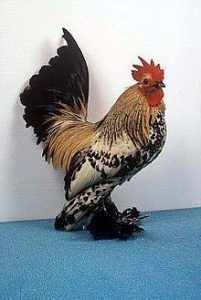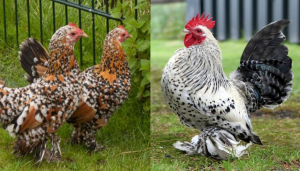 Overview
Overview
Booted Chickens, also known as the Sapelboot, are a rare and ancient bantam breed kept mostly in the Netherlands, with a few breeders in the UK. It is though that their existence has been recorded as early as the 16th century.
This breed is related to the Bearded d’Uccle, the main differences being that the booted chicken is much taller and does not have the famed d’Uccle feathery beard.
Booted Chickens are usually kept for ornamental purposes rather than as a utility chicken. They were officially recognized by the American Poultry Association (APA) in 1878, after being first imported to America a few years before.
Male’s of this breed weigh around 1.9lbs (850g) and females weigh 1.4lbs (650g).
Eggs
Size
Small sized eggs
Color
White or tinted eggs
Production per year
160 eggs per annum

When do they start laying eggs?
From 6 months (so considered later than many other breeds)
Booted Chicken Characteristics
Temperament / Are they good as pets?
These bantams are really friendly and are great for those with kids looking to get a flock.
How do I tame “Booted Chicken” chickens?
Older birds can be tamed by feeding them out of your hand. If you have young chicks you can handle them and pick them up in order to tame them.
How many do I need to buy?
At least 2 chickens, 6 would be ideal for a small chicken coop.
How much space do they need?
They love to forage so they would appreciate being given some space; however, most breeders keep these chickens in a run, which should have 25 square feet per chicken.
Will they mix with my other chickens?
Yes, they’re friendly and won’t cause problems.
Appearance
Booted exhibit extremely developed characteristics, such as vulture hocks, extreme foot feathering or boots, and very erect, well spread tails with prominent breast carried high. They have red wattles and earlobes and have a five pointed single comb. There are lots of different colors this breed comes in from lavender to lemon, the most common is Millefleur.

Feeding
What should I feed them?
As chicks your birds will need nutrients for growth and a smaller version of chicken feed which they’ll be able to eat easily so you should feed them growers mash, this has 19{cfcd481556a8b43fba6af451761032bd323e94372a0c1e607} protein.
Once they’re around 6 weeks they’ll be able to eat chicken pellets which is just chicken feed in a pellet form which has 15-16{cfcd481556a8b43fba6af451761032bd323e94372a0c1e607} protein.
At 18 weeks your chickens will need vitamins and minerals to help produce eggs so start feeding them layers mash or layers pellets which has around 16{cfcd481556a8b43fba6af451761032bd323e94372a0c1e607} protein.
How much should I feed them?
Bantam chickens require less than a standard size chicken so start with 2oz (60g) and adjust accordingly. You can leave the feed there for them to eat when they feel like it or give them it at breakfast.
What can’t they eat?
Moldy foods shouldn’t be given to chickens as they’ll become very sick. For similar reasons, feeding old food from your kitchen is illegal in the UK.
Chocolate should not be given to chickens as it has theobromine which is toxic. The phytohemagglutinin in beans is poisonous and will lead to fatalities once consumed.
What do I need to keep chickens?
The main piece of equipment you’ll need is a chicken coop, which should have 1.1m2 or 11 square feet per chicken. Inside the coop you need a perch for each bird to sleep on and also some nesting boxes. For the run you need 25 square feet per chicken.
Make sure that you have a fence that goes around and over the coop so that they’re safe from any predators. Make sure that there is always water for your chickens, which should be kept in the shade as they won’t drink warm water.
Buy a container which they can’t tip over or get into to stop your water from becoming dirty. Grit is essential in the egg production process so make sure they have some close by to help themselves to at any point.
